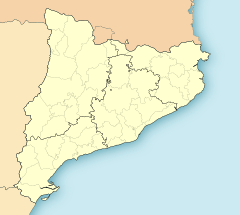Bagà facts for kids
Quick facts for kids
Bagà
|
||
|---|---|---|
|
Municipality
|
||

View from the Tirabal Rock
|
||
|
||

Map showing location within Catalonia
|
||
| Country | Spain | |
| Autonomous community | Catalonia | |
| Province | Barcelona | |
| Comarca | Berguedà | |
| Area | ||
| • Total | 43.1 km2 (16.6 sq mi) | |
| Elevation | 785 m (2,575 ft) | |
| Population
(2018)
|
||
| • Total | 2,152 | |
| • Density | 49.93/km2 (129.32/sq mi) | |
| • Demonym | Baganès baganesa | |
Bagà is a charming municipality (a type of town or district) located in the region of Berguedà, in Catalonia, Spain. It's often seen as the main town of Alt Berguedà, which is the mountainous northern part of the Berguedà region.
Contents
Discover Bagà: A Mountain Town in Catalonia
Bagà is nestled at the very start of the Llobregat river valley. It sits right at the foot of the tall Cadí Mountains. The town itself is quite high up, about 785 meters (2,575 feet) above sea level.
Where is Bagà?
Bagà is located about 20 kilometers (12 miles) north of Berga. It's also 7.5 kilometers (4.7 miles) south of the Túnel del Cadí. This tunnel goes through the Cadí mountain range and connects Bagà with the nearby region of Cerdanya. The municipality of Bagà also includes a small separate piece of land to its west, called an exclave.
A Glimpse into Bagà's Past
Bagà was first settled around the 9th century AD. This happened when a leader named Wilfred the Hairy encouraged people to move back into the Berguedà region. For much of the Middle Ages, a powerful noble family called Pinós controlled most of Alt Berguedà. They managed their lands from Bagà, which made the town quite important.
How Bagà Grew
In the 13th century, Galceran IV de Pinós redesigned the town. Bagà is a rare example of a well-planned medieval city. The town grew quickly. By the early 14th century, a new neighborhood had to be built outside the town walls to fit all the new people. Bagà was also given permission to hold a weekly market. This market still happens today and helped Bagà become a key regional center.
It's interesting to know that some old medieval papers mention a "Hugo of Bagà" as a possible founder of the Knights Templar. However, this is not certain.
Bagà's People and Growth
The number of people living in Bagà has gone up in recent years. This is mainly because people from smaller towns nearby have moved there.
| 1900 | 1930 | 1950 | 1970 | 1981 | 1986 | 2006 |
|---|---|---|---|---|---|---|
| 800 | 1,021 | 1,275 | 2,388 | 2,130 | 2,154 | 2,178 |
What Drives Bagà's Economy?
In the past, Bagà's economy was mostly about the textile industry (making clothes and fabrics) and mining (digging for minerals). These industries were very important from the 18th to the 20th centuries.
However, these industries eventually declined. Now, the region's economy focuses on rural tourism. This means people visit to enjoy the countryside and local culture. Bagà also benefits from winter sports tourists who come from the nearby region of Cerdanya.
The Magical Fia-faia Festival
The Fia-faia is a special celebration that happens in Bagà every Christmas Eve. It's a very old tradition, even older than Christianity, and celebrates the winter solstice (the shortest day of the year).
Here's how it works:
- A big bonfire is lit in the mountains west of the town, where the sun sets.
- After dark, people from the town light faies. These are bundles of a plant called Cephalaria leucanta.
- They carry these burning bundles from the bonfire all the way to the town's main square.
- In the square, they leave the faies on the ground.
- Children then jump over the small fires while singing a special song. The song goes: “Fia-faia, Fia-faia, que nostro senyor ha nascut a la palla” (which means ‘Fia-faia, for our Lord is born in the hay’).
- Afterward, bread is toasted over the fires. People eat it with all i oli (a garlic sauce) or quince paste.
Places to Explore in Bagà
Bagà has several interesting places to visit:
- St. Esteve de Bagà: This is the town's main church. It was built between the 14th and 15th centuries.
- Santuari de la Mare de Déu del Paller: This is a beautiful neoclassical (a style of architecture) sanctuary. It's about two kilometers outside town. It's dedicated to the town's special protector, the “Virgin of the Haystack.”
- Plaça Porxada: This is the town's central square. It was built in the 13th century and is a great example of medieval design.
See also
 In Spanish: Bagá para niños
In Spanish: Bagá para niños




